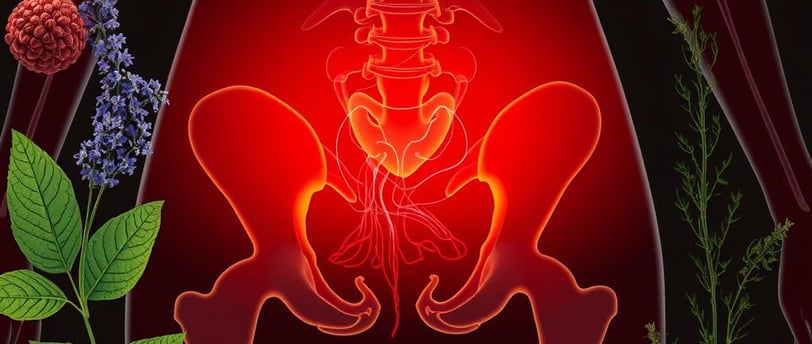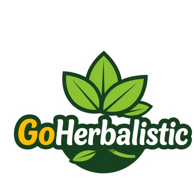Herbal Remedies for Pelvic Inflammation: Best Practices, Usage, and Precautions
Blog post description.
🌿HERBAL REMEDIES


Pelvic inflammation can significantly disrupt the quality of life for those affected, primarily women. It’s a condition often associated with pelvic inflammatory disease (PID), where an infection occurs in the female reproductive organs, though pelvic inflammation may also result from other underlying health issues affecting the pelvic region. While conventional treatments like antibiotics and pain medications remain essential in treating severe cases, there is growing interest in complementary therapies, particularly herbal remedies. This article aims to explore herbal options, their properties, common symptoms of pelvic inflammation, their forms, dosages, potential side effects, and scientifically supported recipes for relief—offering a comprehensive holistic approach.
Understanding Pelvic Inflammation
Pelvic inflammation refers to swelling, irritation, or pain in the pelvic region, often linked to infections caused by bacteria like Chlamydia trachomatis or Neisseria gonorrhoeae. Left untreated, this inflammation can lead to complications such as chronic pelvic pain, infertility, or ectopic pregnancy.
Common Symptoms include:
Lower abdominal or pelvic pain
Fever
Unusual vaginal discharge with an unpleasant odor
Painful urination
Irregular menstrual cycles
Pain during sexual intercourse
The causes of pelvic inflammation range from sexually transmitted infections (STIs) and poor hygiene to postpartum infections and pelvic surgeries. While conventional treatments are typically prescribed, herbal remedies are increasingly being explored as an adjunct therapy for their anti-inflammatory, antimicrobial, and pain-relieving benefits.
Forms Available for Herbal Remedies
Herbal remedies for pelvic inflammation are available in various forms, offering convenience and flexibility based on personal preferences. Here are the most common forms:
Teas and Infusions: Ideal for gentle support. Herbal teas made from anti-inflammatory and antibacterial herbs like chamomile, ginger, and turmeric are widely used.
Capsules and Tablets: Concentrated forms of herbal extracts, such as curcumin (from turmeric) or echinacea, are prepared as easy-to-swallow supplements.
Essential Oils: Essential oils like tea tree oil offer localized benefits and are typically used in aromatherapy or diluted for topical application.
Poultices and Compresses: External applications using herbal preparations, such as calendula compresses, help to alleviate pain.
Tinctures and Syrups: These concentrated liquid forms are taken orally for quick absorption.
Herbal Remedies Backed by Scientific Evidence
Turmeric (Curcuma longa)
Known for its potent anti-inflammatory and antimicrobial properties, turmeric has been identified as a promising remedy for reducing inflammation. The active compound, curcumin, inhibits inflammatory pathways and promotes healing.
Dosage: 400–600 mg of curcumin extract 2-3 times daily or 1-2 teaspoons of turmeric powder in teas or recipes. Scientific Evidence: A 2020 study in Frontiers in Pharmacology confirms curcumin’s effect in reducing inflammatory markers in pelvic infections.
Recipes: Turmeric-laced tea made with honey and black pepper (to improve absorption) is a well-known remedy.Echinacea (Echinacea purpurea)
Echinacea is celebrated for its immune-boosting and antimicrobial powers. It’s particularly useful for fighting bacterial infections that lead to or exacerbate pelvic inflammation.
Dosage: 300–500 mg of standardized extract, 3 times a day.
Scientific Evidence: A 2018 meta-analysis indicates that echinacea may shorten the duration of infections, making it an effective complementary therapy.
Forms Available: Capsules or steeped as a tea.Ginger (Zingiber officinale)
Ginger has antioxidant and anti-inflammatory properties that can reduce pelvic pain and swelling naturally.
Dosage: 1–2 grams of fresh ginger or 250–500 mg of ginger extract daily.
Scientific Evidence: In a 2015 study published in Phytotherapy Research, ginger demonstrated effectiveness in reducing pain in women with pelvic inflammatory conditions.
Recipes: Boil 2 inches of fresh ginger root in water, add honey, and consume. Ginger can also be included in soups or smoothies.Calendula (Calendula officinalis)
Calendula is often used externally in poultices or compresses for its ability to soothe inflammation and prevent infection.
Dosage: Applied externally 2-3 times daily in diluted forms or teas made from dried calendula flowers consumed once daily.
Scientific Evidence: The Journal of Medicinal Plants Research suggests calendula as a safe antimicrobial with wound-healing capabilities.Tea Tree Oil (Melaleuca alternifolia)
Tea tree oil has natural antibacterial and antifungal properties, making it useful for pelvic inflammation related to infections. It is used primarily in sitz baths to reduce inflammation and fight bacteria.
Dosage: Add a few drops (3–4) of tea tree oil to a warm sitz bath. Ensure it is diluted before use.
Precaution: Tea tree oil is potent. Direct application can cause skin irritation, so it must always be diluted.
Herbal Recipes for Pelvic Inflammation
Here are two herbal recipes you can try at home:
Anti-Inflammatory Ginger-Turmeric Tea
Ingredients: 1 tsp turmeric powder, 1-inch ginger, 1 tsp honey, 2 cups water.
Instructions: Boil ginger and turmeric in water for 10 minutes, strain, add honey, and enjoy twice a day.
Calendula and Chamomile Sitz Bath
Ingredients: 2 tbsp dried calendula flowers, 2 tbsp dried chamomile flowers, a few drops of lavender oil, and warm water.
Instructions: Add the herbs to a sachet bag, steep in hot water, and pour the mixture into a sitz bath. Sit for 15–20 minutes.
Dosage and Side Effect Precautions
While herbal remedies offer promising benefits, proper dosages and precautions must be adhered to:
Start Small: Always begin with a low dose and increase gradually to prevent adverse reactions.
Consult a Professional: Speak with a healthcare provider, especially if you’re pregnant, nursing, or taking other medications.
Allergies and Sensitivities: Herbs like echinacea and ginger can trigger allergic reactions in sensitive individuals.
Drug Interactions: For example, turmeric may interact with blood-thinning medications like warfarin.
Common side effects may include nausea, diarrhea, or allergic skin reactions, particularly if the herbs are used excessively or improperly.
Supported by Science
Several scientific studies validate the effectiveness of herbal remedies in managing inflammation. For instance:
A 2019 article in the Journal of Ethnopharmacology highlights turmeric’s role in neutralizing toxins that exacerbate pelvic inflammation.
Studies published in Research in Complementary Medicine emphasize the benefits of echinacea and ginger for managing bacterial and inflammatory conditions.
While more large-scale research is needed for conclusive evidence, traditional and preliminary findings give weight to the efficacy of these treatments.
Final Thoughts
Herbal remedies for pelvic inflammation can offer natural, accessible relief. Incorporating these herbs into daily routines using teas, tinctures, sitz baths, or compresses can complement conventional treatments while addressing inflammation at its root. However, self-medication can be risky. Always consult a licensed healthcare practitioner before starting herbal remedies, and monitor both benefits and side effects.
By integrating ancient remedies with modern guidelines, you can achieve a balanced, holistic approach to maintaining pelvic health and well-being—one herb at a time.
References:
"Anti-inflammatory properties of turmeric and ginger," Frontiers in Pharmacology, 2020
"Calendula officinalis: A medicinal marvel," Journal of Medicinal Plants Research, 2018
"Echinacea and immunity," Phytotherapy Research, 2018
